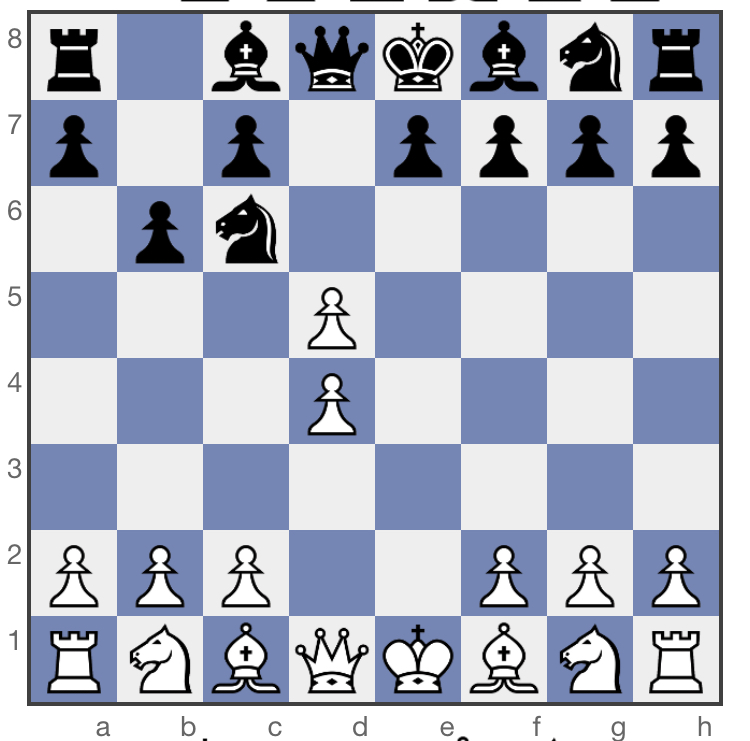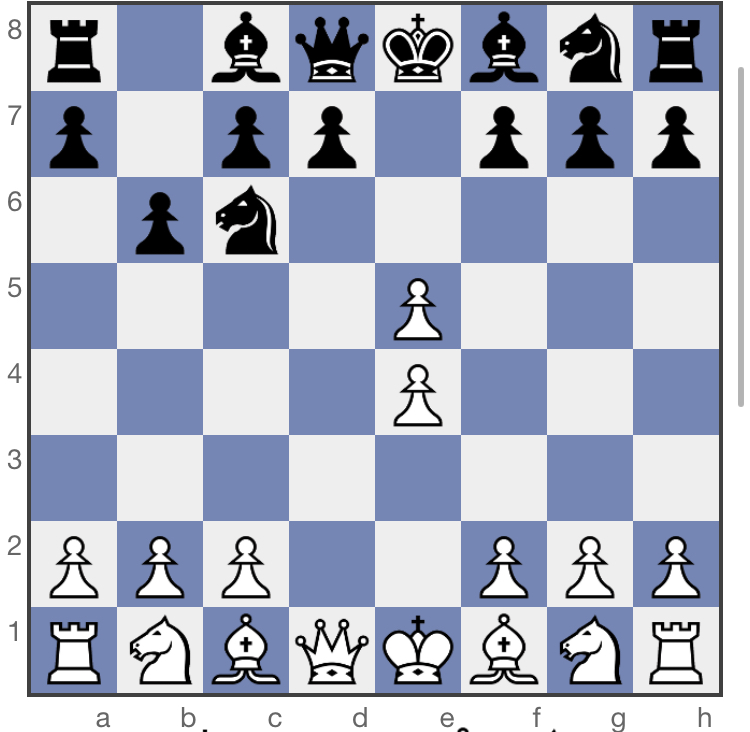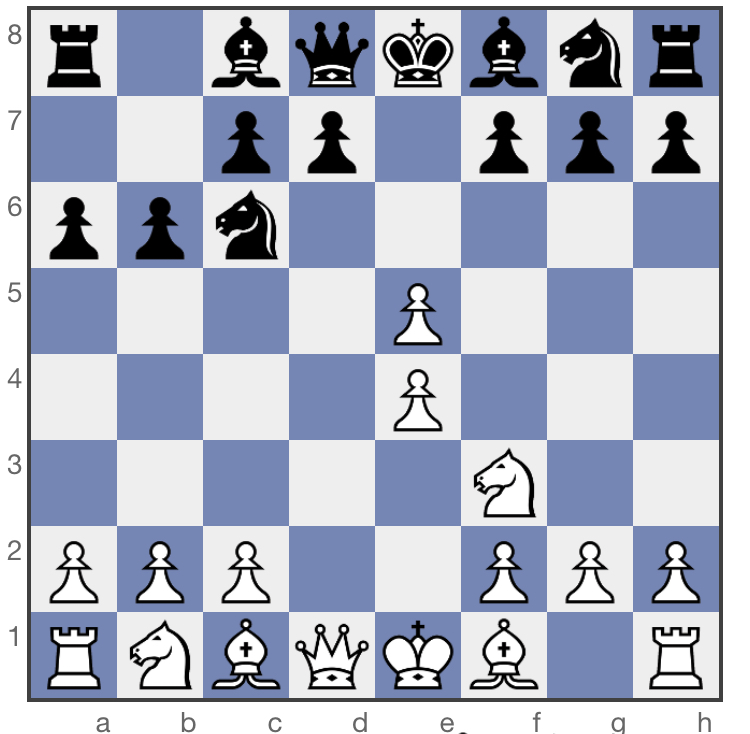Pawn to Queen’s Knight 3 (b6)
Cooper enlists Pete’s help in Episode 22. This is the move Pete makes in Episode 23 after much deliberation, which he says will guarantee some sleepless nights, and ensures that Earle won’t be able to take a piece for five or six moves. At this point, it seems Coop’s opening move has been definitively retconned to Pawn to King 4 (e5), despite what the personals column said in Episode 19. Not only have the boards in the sheriff’s station reflected this move for three episodes straight, Pete’s move makes no sense if Cooper’s initial move was P to Q4, because Pete’s move would allow Earle to take Cooper’s Knight (dxc6) on the next move! See below board, which would reflect the positions of the pieces after Pete’s move, if Cooper’s initial move were as posted in the personals:

- 72E57270-83CE-42FA-9A3D-878753D25732.jpeg (213.2 KiB) Viewed 9212 times
Here are the positions if we accept that Cooper’s initial move has been retconned, as reflected by the chessboards in the sheriff’s station:

- 8D79048C-3E8D-464A-B913-E0ED544651A6.jpeg (224.44 KiB) Viewed 9212 times
From here on out, the chessboards seen on screen which are meant to reflect the actual gameplay are all accurate to this retconned version of the game.
Pete references José Raúl Capablanca and Emanuel Lasker’s 1914 match in St. Petersburg when contemplating his move. Lasker actually bested Capablanca, coming in first in
the tournament and beating Capablanca in a very famous game, so this actually wasn’t a proud moment for Pete’s hero (who like Cooper was playing Black, and apparently played too passive a game). Perhaps Pete is using Capablanca’s defeat as a learning tool rather than a guide. If Cooper’s response to Earle’s initial move was indeed e5, then this would have been the same opening as
that match. This is called an
Open Game, and is possibly the most common response to the King’s Pawn Game. Earle’s second move, leading toward a “classical confrontation,” would then have been luring Cooper into the
Danish Gambit, which Cooper rejects on his second move, pivoting into the Nimzowitsch Defense, as discussed above.
Pete’s move doesn’t on its face seem to have any relation to the Lasker-Capablanca conflict, nor does it seem to be a move with much support in the general chess community. At this point, we seem to be out in the wilderness: this is most definitely not a classical confrontation. And maybe that’s the point. By asking Pete to devise a game where the fewest possible pieces are lost, Cooper has revised the rules of the typically utilitarian game, wherein pieces are routinely sacrificed in the name of broader strategy. It would be interesting to see a great chess strategist try to play under Cooper’s rules in real life, and see what the results would be. I’m not well-versed enough to be able to project what Pete’s overall strategy is, but I would love it if someone on here were able to posit a theory! It’s worth noting that, although Pete claims Earle can’t take a piece for five or six moves, the Black Queen’s Pawn is exposed, and Earle could technically take it on the next move if he really wanted to kill someone else, but this would be terrible strategy, as he would be sacrificing his Queen very early in the game.
In Episode 24, Earle’s board now accurately reflects the same state of play as the sheriff’s station boards (with Cooper’s retconned first move). Earle’s reaction to Pete’s move is that it’s a trick, and he realizes Cooper has gotten help and is playing a stalemate game. Meanwhile, Pete stresses about the fact that a stalemate with no pieces lost is impossible: he references a “classic Herbstmann” (referring to famed chess composer
Alexander Herbstmann) which leaves Black with six pieces. Pete claims he can improve on this, but even if they keep twelve pieces, six people die. (This is a strange line. Each side has sixteen pieces, so if Pete managed to keep twelve, then only four people would die. This is presumably a really careless writing mistake.) Cooper says to place an emphasis on royalty as he believes Earle is impatient and doesn’t want pawns.
4.
Knight to King’s Bishop 3 (Nf3)
Getting more theatrical, Earle drops off his fourth move at the Hayward house in Episode 24, while cosplaying as Will’s late classmate Gerald Craig. This move transposes the game into a sort of variant on the
Scotch Game.

- 4D243084-A257-4EFF-8934-3DD8E19FE619.jpeg (208.63 KiB) Viewed 9165 times
Pawn to Queen’s Rook 3 (a6)
Pete calls in this move in Episode 25. Cooper correctly notes that it exposes the pawn to Earle’s King’s Bishop, but that Earle is unlikely to take the pawn as he would be sacrificing his Bishop “and most of his initial advantage” (Cooper’s Queen’s Rook would be able to take the Bishop on the next move).

- 6D7FD30E-6C88-42ED-8E12-1D1D0C95EC5A.jpeg (209.31 KiB) Viewed 9130 times
5.
Bishop Takes Queen’s Rook’s Pawn (Bxa6)
Earle takes his second pawn with the death of Rusty Tomaski, roadie and beer-lover (Ted Raimi), in Episode 26. Cooper notes that Earle didn’t tell them his move and is playing off the board. There are two possible moves by which Earle might have taken a pawn: this move (which Cooper noted as a possibility when Pete called in the last move in Episode 25, but he assumed Earle would not make such a strategically unsound move), and Queen takes Queen’s Pawn (Qxd7), which would have been even crazier to do. In either instance, Earle is forfeiting a valuable piece for a mere pawn. However, the Bishop has less value than the Queen, so this is the more sensible move between the two. Indeed, based on the brief glimpse we get of Earle’s chessboard before he shoves the pieces off the table, this is exactly what he did. Clearly, at this point, he’s far more interested in killing people and toying with Cooper than playing a serious game.

- 00DF6332-230F-4BDA-A02B-D264F766CE5A.jpeg (221.12 KiB) Viewed 9095 times
The game is over, with no resolution. Thanks for playing! I’d love it if anyone on the board who’s an actual strategist could chime in and contribute their thoughts on any of the above.
